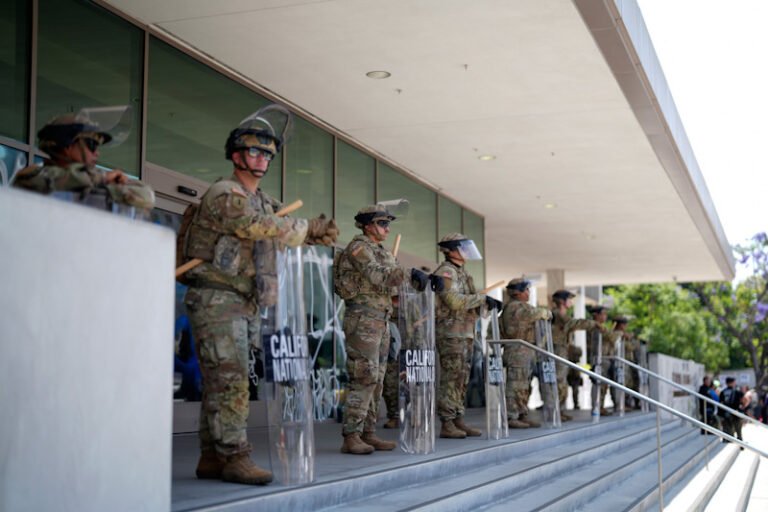Constitutional Law
Did Trump violate law by deploying National Guard troops? Commentators see issues as California sues

National Guard troops stand guard near the Metropolitan Detention Center on June 9 in downtown Los Angeles. (Photo by Eric Thayer/The Associated Press)
The state of California is filing a lawsuit that seeks to set aside President Donald Trump’s order sending at least 2,000 state National Guard troops to Los Angeles in response to protests there over immigration raids, the state announced Monday.
The suit by California Gov. Gavin Newsom and the state’s attorney general, Rob Bonta, claims that Trump exceeded his authority when he invoked Section 12406 of Title 10 of the U.S. Code.
The suit was filed before Trump deployed an additional 2,000 National Guard troops and 700 Marines to the area Monday evening, the Washington Post reports. Newsom said he would also sue over the Marines deployment.
Section 12406 allows the federal government to call National Guard troops into federal service in cases of “rebellion or danger of rebellion” against the authority of the U.S. government, explain Reuters and the New York Times. The law also allows deployment when a president is “unable with the regular forces to execute the laws of the United States.”
Trump said he was invoking the law to protect federal personnel, including members of U.S. Immigration and Customs Enforcement.
Trump authorized the Department of Defense to call up the National Guard troops over the objections of local law enforcement and without authorization from Newsom, according to the suit announcement.
“Let me be clear: There is no invasion,” Bonta said in a June 9 press release. “The president is trying to manufacture chaos and crisis on the ground for his own political ends. Federalizing the California National Guard is an abuse of the president’s authority under the law.”
The suit also claims that Section 12406 requires a governor to consent to federalization of the National Guard, according to California’s announcement. The section says “orders for these purposes shall be issued through the governors of the states.”
The suit also claims that Trump’s order violated the Tenth Amendment, which reserves power to the states and the people if not delegated to the federal government.
The Washington Post and the New York Times have coverage of the suit. The announcement follows coverage of the legal issues by the New York Times, the Washington Post and Reuters.
Trump’s order “raises many legal complexities,” the New York Times reports, “including whether a rebellion against federal authority is indeed taking place and whether a court could reject a president’s claim that the situation rises to the level that would make it lawful to send in troops.”
The New York Times pointed to another issue: whether it was lawful to exclude Newsom from the decision-making process.
Legal experts told Reuters that the California protests don’t amount to a rebellion and don’t prevent the United States from executing federal law.
But the experts were apparently less sure about the need to get Newsom’s consent under a provision of Title 10 that says “orders for these purposes shall be issued through the governors of the states.” Experts told Reuters that the language likely reflected norms for deployment, rather than an intent to allow governors to block presidential orders.
The New York Times noted that Trump’s order also cited “the authority vested in me as president by the Constitution” in calling up the National Guard. That could mean that he thinks that he has inherent power to use those troops in the United States.
Former Chief Justice of the United States William H. Rehnquist endorsed that view of inherent power while he was working in the Department of Justice’s Office of Legal Counsel—before he joined the U.S. Supreme Court, the New York Times says.
“But there was no definitive court test of that idea,” the New York Times reports.
Another legal issue involves Trump’s invocation of Section 12406 without also citing the Insurrection Act, which allows federal troops to participate in civilian law enforcement to suppress armed rebellions and riots.
The Insurrection Act creates an exception to the Posse Comitatus Act, which generally bars using federal troops for policing in the United States.
Because Trump didn’t invoke the Insurrection Act, the National Guard troops won’t be allowed to engage in ordinary law enforcement activities without violating the Posse Comitatus Act, wrote Stephen Vladeck, a professor at the Georgetown University Law Center, on his One First blog on Substack.
“All that these troops will be able to do is provide a form of force protection and other logistical support for ICE personnel,” Vladeck said.
Former President George H.W. Bush used both laws when he federalized the National Guard in 1992 to control riots after police officers were acquitted in the beating of Rodney King, a Black motorist, according to Elizabeth Goitein, senior director of the Liberty and National Security Program at the Brennan Center for Justice, an independent law and policy organization at the New York University School of Law, in an interview with the Washington Post.
Bush also acted in response to the then-governor’s request, which is not the case now.
The last time that the federal government used Section 12406 without a governor’s request was in 1965, when former President Lyndon B. Johnson sent troops to Alabama to protect civil rights demonstrators, Goitein told the New York Times.
Write a letter to the editor, share a story tip or update, or report an error.

